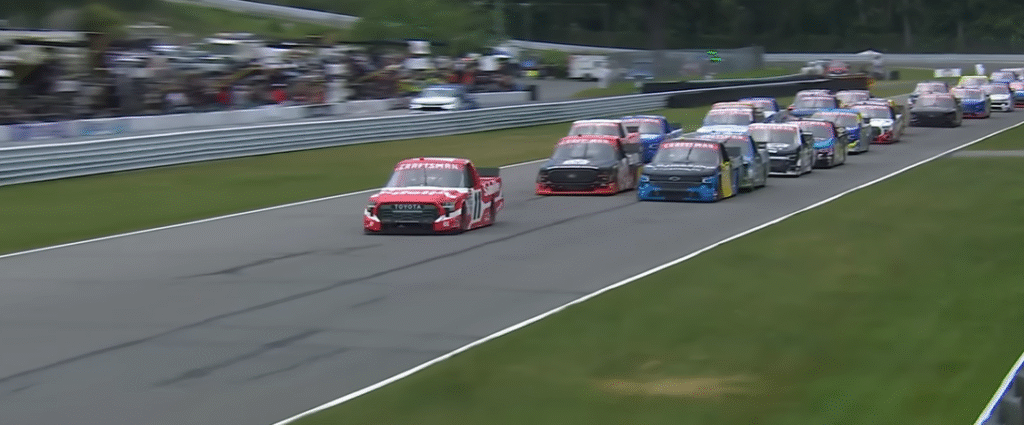Lime Rock Park – Venue Overview
| Name | Lime Rock Park |
|---|---|
| Location | Lakeville, Connecticut, USA |
| Opened | April 27, 1957 |
| Owner | Lime Rock Group, LLC |
| Previous Owner | Skip Barber (1984–2021) |
| Track Length | 1.478 miles (2.378 km) |
| Surface | Asphalt |
| Notable Events | Trans-Am, ARCA, IMSA, NASCAR Truck Series |
| Historic Recognition | Added to U.S. National Register of Historic Places, 2009 |
| Official Website | www.limerock.com |

Under the Connecticut hills, the hum of racing engines and the weight of history have been balancing in the air around Lime Rock Park in recent days. With the first-ever NASCAR Craftsman Truck Series, this small 1.478-mile natural-terrain course has made a spectacular comeback. More than just a race, the debut served as a startling reminder that small venues can still influence national narratives if they are carefully managed and authentically preserved.
Lime Rock Park was created with the land, not against it, and was formally opened in 1957 after being constructed in 1956. Fans can camp under trees and sit on grassy banks as though they were at a country concert rather than a motorsport event because of the way it is laid out, which follows the contours of the Berkshire foothills. This closeness is especially helpful. It helps foster a strong bond between the track and its community, which has developed, waned, and significantly improved over the years, and it keeps fans close to the action.
Everything that already made Lime Rock a favorite was heightened by the recent NASCAR event. Drivers were tested in ways that were both technically difficult and aesthetically pleasing as trucks roared through seven wide turns. Daniel Hemric poetically captured the delicate balance between throttle and control when he characterized the feeling of climbing Turn 5 and plunging into Turn 7 as “a timing thing.” The elevation changes put instincts to the test in addition to equipment. From the hillside, spectators applauded for both speed and poise under duress.
This course is especially innovative because of its contrast. Lime Rock doesn’t have grandstands or large facilities like many of the NASCAR tracks on its rotation. Rather, it embraces its small size and organic appearance. Everything feels close enough to touch, making binoculars seem unnecessary in this unique location. By enabling fans to follow every error, comeback, and duel without the use of jumbotrons or headsets, the close proximity improves storytelling.
The unpredictable nature of the weekend was further increased by the arrival of newcomers. Drivers with extensive endurance series and open-wheel racing experience, such as Thomas Annunziata, Jordan Taylor, and Alex Labbe, arrived. In terms of driver development and talent discovery, their versatility was impressively demonstrated, demonstrating how incredibly versatile a shorter, tighter layout can be.
Crew chiefs had to reconsider their setups from a strategic standpoint. Balance with a bias was necessary to build a car that could absorb cornering stress without sacrificing forward momentum because of Lime Rock’s limited left-hand turns and abrupt elevation changes. Another layer of uncertainty was introduced when rain during practice forced teams to prepare for wet weather. Ty Majeski, his driver, is especially good in the rain, according to Joe Shear Jr., which could be very helpful on subsequent trips.
Lime Rock has never been about consistency in the past. In the past, it was the site of Formula Libre races, which permitted midget and sports cars to share the same grid. A regular at the track for many years, Paul Newman frequently referred to Lime Rock as his favorite racing location. These days, it feels more like an evolution than an intrusion when NASCAR trucks are present. There is something especially significant about a location that simultaneously evokes memories and fresh starts.
The venue’s revitalization received fresh attention over the weekend as well. Dale Quarterley noted that by repairing fences, updating facilities, and restoring the grounds to their former splendor, the management has greatly diminished the indications of aging. For devoted fans, it served as both a reminder of Lime Rock’s past and a compelling argument for its future.
The event was a catalyst for the economy. Local eateries had one of their busiest weekends of the year, and hotels in neighboring towns reported full bookings. Lime Rock provided an experience that was a unique blend of scenic charm and fast-paced competition. It drew curious families, racing enthusiasts, and casual adventurers who just wanted to sit on a blanket and listen to the sound of engines.
The race acted as a social bridge. People from many generations and places gathered under one common sky. While older spectators in lawn chairs recalled previous races involving Mario Andretti or Stirling Moss, younger fans waved flags. Above all, the atmosphere was very effective at reminding us why motorsport persists, particularly when it is set in a setting that appreciates its cadence.
A more significant change is indicated by Lime Rock’s return to national racing circuits. It shows a desire for places that are tactile and real, where the distance between a driver and a fan is measured in feet rather than fences. It demonstrates that advancement does not always equate to growth. It can also mean restoration. Furthermore, Lime Rock has demonstrated that it is still very much alive—possibly more so now than ever before—despite being remarkably resilient over decades of change.
